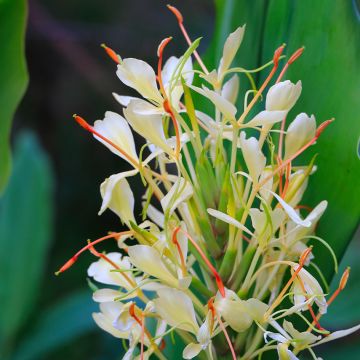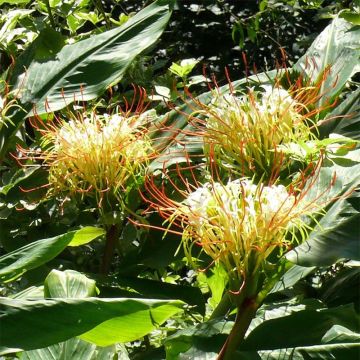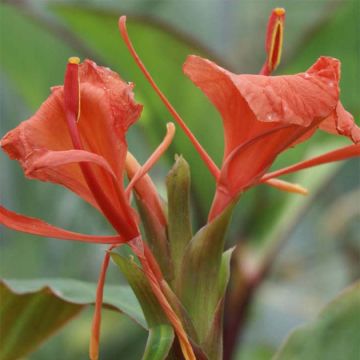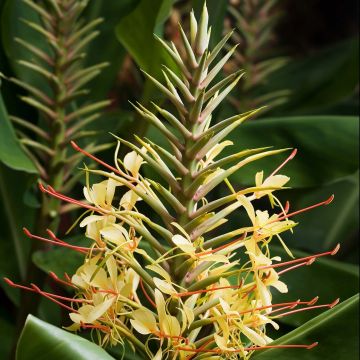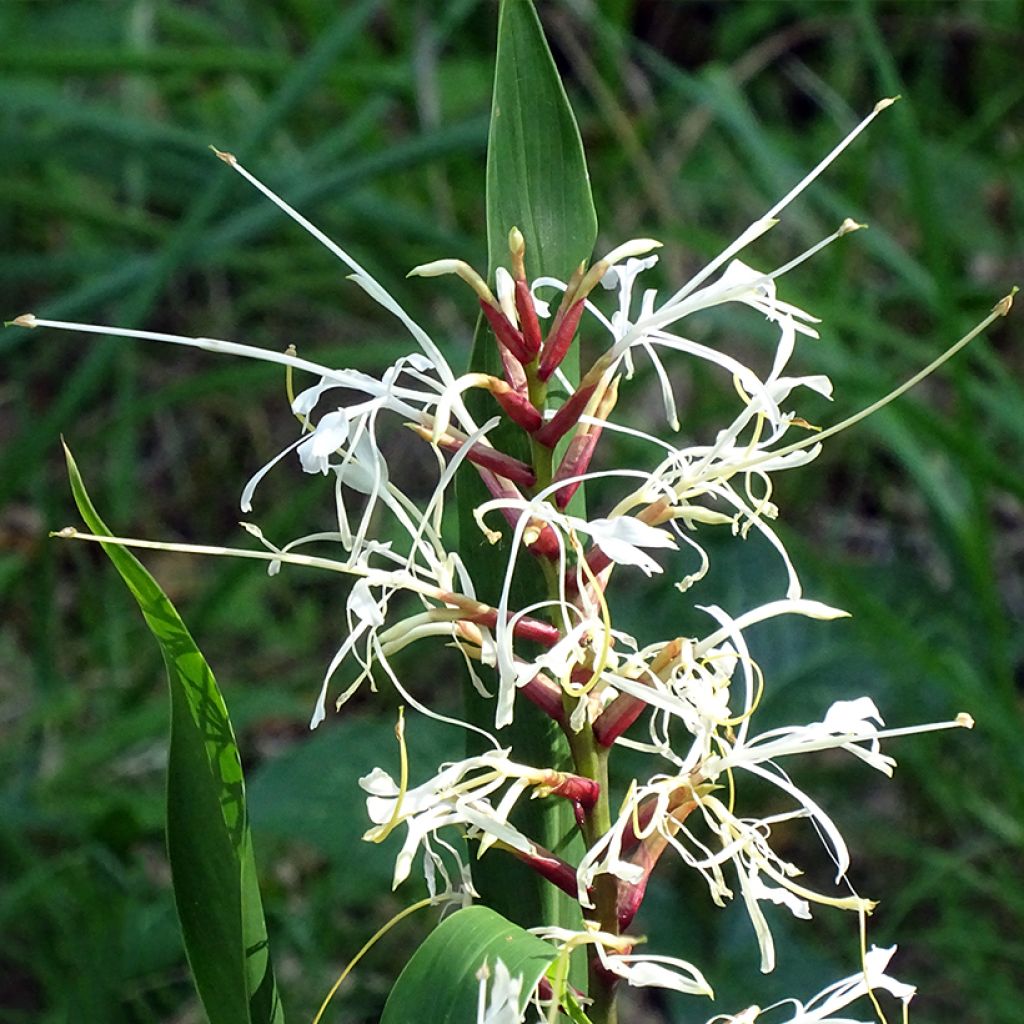

Hedychium villosum Tenuiflorum - Gingembre d'ornement
Hedychium villosum var. tenuiflorum
Hedychium villosum var. tenuiflorum
Ginger Lily
This item cannot be shipped to the selected country
Delivery charge from €5.90
More information
Schedule delivery date,
and select date in basket
This plant carries a 12 months recovery warranty
More information
We guarantee the quality of our plants for a full growing cycle, and will replace at our expense any plant that fails to recover under normal climatic and planting conditions.
From €5.90 for pickup delivery and €6.90 for home delivery
Express home delivery from €8.90.
Does this plant fit my garden?
Set up your Plantfit profile →
Description
Hedychium villosum var. tenuiflorum is a small-sized ornamental ginger that will charm enthusiasts with its bamboo-like appearance and its autumnal flowering, both faithful and delicate. This species, which prefers partial shade and is often epiphytic in its native Asian mountains, develops multiple stems with rather elongated, narrow leaves that persist throughout the frost-free winter. Its spider-like flowers, white with red bracts, are arranged in graceful spikes. Not very hardy, this variety can nevertheless be easily cultivated in a conservatory, in a humus-rich, moist, but well-draining growing medium. In favourable climates, it makes for a delightful exotic undergrowth plant.
Hedychium villosum var. tenuiflorum is native to the mountainous regions of Vietnam, China, northeastern India, Thailand and Malaysia. Like all ornamental gingers, it belongs to the Zingiberaceae family. It is a herbaceous plant that grows from a fleshy rhizome. The aerial vegetation theoretically persists in winter, but disappears as soon as it freezes. The rhizome can withstand brief frosts of around -7 to -10 °C if well protected, giving rise to new shoots the following spring. The underground rhizome produces several slender stems each year, bearing lanceolate leaves that are fairly dark green and somewhat reminiscent of certain bamboos. The clump gradually expands year after year, reaching about 50 to 60cm (20 to 24in) in all directions. Its inflorescences generally appear in November, depending on the climate. They are ellipsoid in shape. The flowers are tubular and white in colour, emerging from reddish bracts.
Hedychium villosum var. tenuiflorum is ideal for adding a touch of exoticism and lushness to a garden that is well protected from the whims of the weather. Planted in partial shade, alongside other Hedychiums and Colocasias, the effect of being transported elsewhere will be guaranteed! It will also find its place in a large pot on the terrace, in a semi-shaded position and in soil that remains moist. The pot should be brought indoors in autumn to enjoy its flowering, which continues until December. Some landscapers also use it in vertical gardens.
Report an error about the product description
Flowering
Foliage
Plant habit
Botanical data
Hedychium
villosum var. tenuiflorum
Zingiberaceae
Ginger Lily
Southeast Asia
Other Hedychium
Planting and care
Hedychiums are known to be tender plants due to their poor cold resistance. Hedychium villosum var. tenuiflorum is a semi-hardy variety capable of withstanding negative temperature spikes of around -7 to -10 degrees (19.4 to 14°F) Celsius at its peak, under a thick protective mulch. As soon as the first frost hits, cut back the foliage to ground level and then mulch the stumps with a thick layer of dead leaves, which will protect them from both the cold and excessive moisture. Choose a partially shaded location, sheltered from strong winds. The soil should remain slightly moist, especially during the entire growing and flowering period. A rich, light, well-drained soil is best suited for this plant.
Cultivating in large pots is preferable in colder regions. In this case, the plant should be stored frost-free in a bright, unheated room during winter, such as a bright conservatory (avoid direct sunlight exposure). Regular watering should be maintained throughout the year.
Planting period
Intended location
Care
This item has not been reviewed yet - be the first to leave a review about it.
Haven't found what you were looking for?
Hardiness is the lowest winter temperature a plant can endure without suffering serious damage or even dying. However, hardiness is affected by location (a sheltered area, such as a patio), protection (winter cover) and soil type (hardiness is improved by well-drained soil).

Photo Sharing Terms & Conditions
In order to encourage gardeners to interact and share their experiences, Promesse de fleurs offers various media enabling content to be uploaded onto its Site - in particular via the ‘Photo sharing’ module.
The User agrees to refrain from:
- Posting any content that is illegal, prejudicial, insulting, racist, inciteful to hatred, revisionist, contrary to public decency, that infringes on privacy or on the privacy rights of third parties, in particular the publicity rights of persons and goods, intellectual property rights, or the right to privacy.
- Submitting content on behalf of a third party;
- Impersonate the identity of a third party and/or publish any personal information about a third party;
In general, the User undertakes to refrain from any unethical behaviour.
All Content (in particular text, comments, files, images, photos, videos, creative works, etc.), which may be subject to property or intellectual property rights, image or other private rights, shall remain the property of the User, subject to the limited rights granted by the terms of the licence granted by Promesse de fleurs as stated below. Users are at liberty to publish or not to publish such Content on the Site, notably via the ‘Photo Sharing’ facility, and accept that this Content shall be made public and freely accessible, notably on the Internet.
Users further acknowledge, undertake to have ,and guarantee that they hold all necessary rights and permissions to publish such material on the Site, in particular with regard to the legislation in force pertaining to any privacy, property, intellectual property, image, or contractual rights, or rights of any other nature. By publishing such Content on the Site, Users acknowledge accepting full liability as publishers of the Content within the meaning of the law, and grant Promesse de fleurs, free of charge, an inclusive, worldwide licence for the said Content for the entire duration of its publication, including all reproduction, representation, up/downloading, displaying, performing, transmission, and storage rights.
Users also grant permission for their name to be linked to the Content and accept that this link may not always be made available.
By engaging in posting material, Users consent to their Content becoming automatically accessible on the Internet, in particular on other sites and/or blogs and/or web pages of the Promesse de fleurs site, including in particular social pages and the Promesse de fleurs catalogue.
Users may secure the removal of entrusted content free of charge by issuing a simple request via our contact form.
The flowering period indicated on our website applies to countries and regions located in USDA zone 8 (France, the United Kingdom, Ireland, the Netherlands, etc.)
It will vary according to where you live:
- In zones 9 to 10 (Italy, Spain, Greece, etc.), flowering will occur about 2 to 4 weeks earlier.
- In zones 6 to 7 (Germany, Poland, Slovenia, and lower mountainous regions), flowering will be delayed by 2 to 3 weeks.
- In zone 5 (Central Europe, Scandinavia), blooming will be delayed by 3 to 5 weeks.
In temperate climates, pruning of spring-flowering shrubs (forsythia, spireas, etc.) should be done just after flowering.
Pruning of summer-flowering shrubs (Indian Lilac, Perovskia, etc.) can be done in winter or spring.
In cold regions as well as with frost-sensitive plants, avoid pruning too early when severe frosts may still occur.
The planting period indicated on our website applies to countries and regions located in USDA zone 8 (France, United Kingdom, Ireland, Netherlands).
It will vary according to where you live:
- In Mediterranean zones (Marseille, Madrid, Milan, etc.), autumn and winter are the best planting periods.
- In continental zones (Strasbourg, Munich, Vienna, etc.), delay planting by 2 to 3 weeks in spring and bring it forward by 2 to 4 weeks in autumn.
- In mountainous regions (the Alps, Pyrenees, Carpathians, etc.), it is best to plant in late spring (May-June) or late summer (August-September).
The harvesting period indicated on our website applies to countries and regions in USDA zone 8 (France, England, Ireland, the Netherlands).
In colder areas (Scandinavia, Poland, Austria...) fruit and vegetable harvests are likely to be delayed by 3-4 weeks.
In warmer areas (Italy, Spain, Greece, etc.), harvesting will probably take place earlier, depending on weather conditions.
The sowing periods indicated on our website apply to countries and regions within USDA Zone 8 (France, UK, Ireland, Netherlands).
In colder areas (Scandinavia, Poland, Austria...), delay any outdoor sowing by 3-4 weeks, or sow under glass.
In warmer climes (Italy, Spain, Greece, etc.), bring outdoor sowing forward by a few weeks.

































